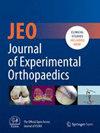Digital hand-held arthrometry is a reliable and accurate adjunct for diagnosing acute anterior cruciate ligament tears
Abstract
Purpose
To evaluate the intrarater reliability and predictive validity of Lachmeter® measurements for diagnosing acute anterior cruciate ligament (ACL) tears, and to propose diagnostic thresholds.
Methods
Lachmeter® measurements were recorded during the stabilised Lachman test for consecutive participants presenting to an acute knee injury clinic within 21-days of injury. Intrarater reliability for individual limb and side-to-side (STS) difference (injured limb minus uninjured limb) measurements was investigated using a cross-sectional, repeated-measures design and the intraclass correlation coefficient (ICC). The predictive validity of STS difference and injured limb measurements was investigated using a prospective cohort design; sensitivity, specificity, negative (LR−) and positive likelihood ratios (LR+) were calculated using magnetic resonance imaging as the reference standard.
Results
Intrarater reliability was excellent for individual limb and STS difference measurements in 102 participants. Of the 63 participants included in the validity analysis, 31 had a normal ACL and 32 had an ACL tear. LR- point estimates for STS differences <1.4 mm (0.07 [95% confidence interval [CI]: 0.02–0.29]) or injured limb measurements <7.5 mm (0.09 [95% CI: 0.02–0.34] produced ‘large’ shifts in the probability of ruling out an ACL tear. LR+ point estimates for STS differences ≥3.8 mm (10.67 [95% CI: 2.68–42.51]) or injured limb measurements ≥11.8 mm (10.67 [95% CI: 1.42–80.26]) produced ‘large’ shifts in the probability of ruling in a full-thickness ACL tear.
Conclusion
In participants presenting within 21-days of knee injury, intrarater reliability was excellent for Lachmeter® measurements recorded during the stabilised Lachman test. Based on predictive validity estimates, Lachmeter® measurements can be used to differentiate normal from torn ACLs in acute presentations, but not partial from full-thickness ACL tears. Diagnostic thresholds are proposed based on STS difference and injured limb measurements, and with consideration of the Lachman end point.
Level of Evidence: Level I.


 求助内容:
求助内容: 应助结果提醒方式:
应助结果提醒方式:


